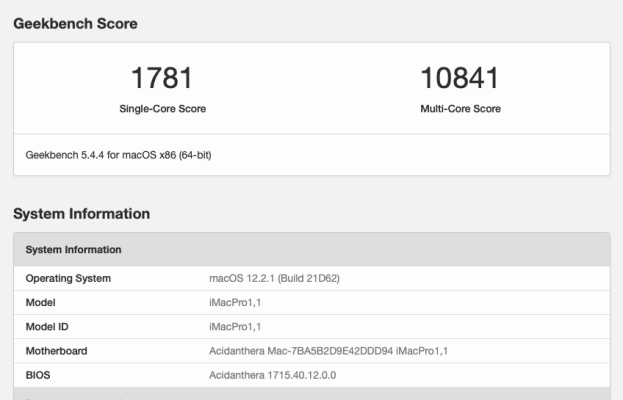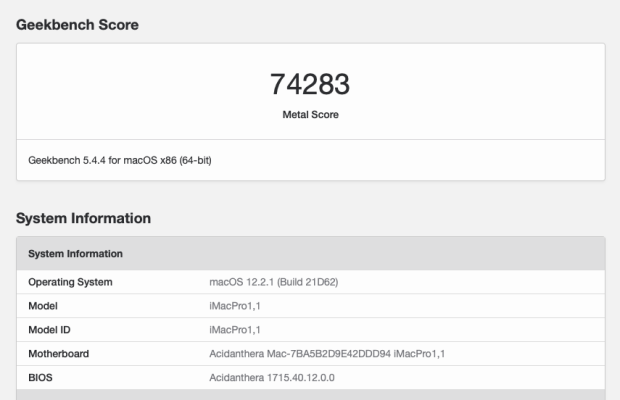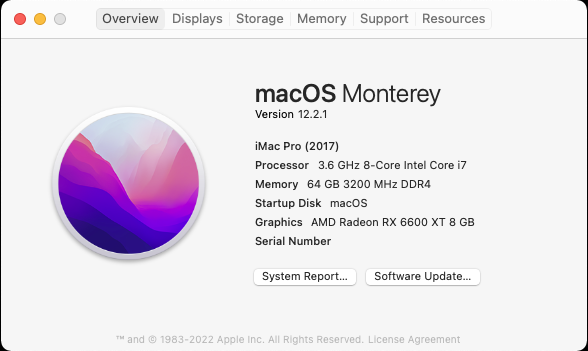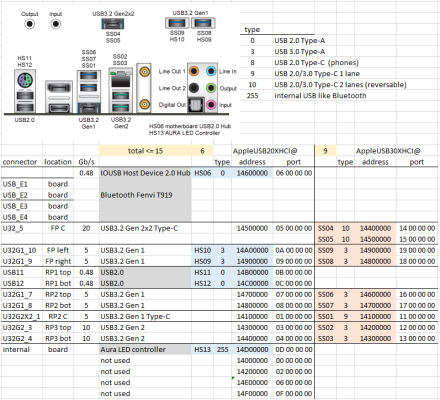- Joined
- Feb 20, 2022
- Messages
- 9
- Motherboard
- Asus Tuf Gaming Z590-Plus WiFi
- CPU
- i7-11700k 3.6GHz
- Graphics
- Asus Dual AMD Radeon RX 6600 XT 8GB
My first hackintosh, advice is welcome!
OpenCore-0.7.8-Release
iMacPro1,1
Monterey 12.2.1
Asus Tuf Gaming Z590-Plus WiFi ATX LGA1200
I7-11700K, 3.6GHz, 16MB Cache, LGA1200
Intel 11th generation Rocket Lake Z590 chipset
Intel UHD Graphics 750 (not supported by macOS)
Intel Ethernet controller I225-V 2.5Gb
Intel WiFi 6 AX201 160MHz (not supported by macOS)
Realtek ALC S1200A 7.1 audio codec
ASUS Dual AMD Radeon RX 6600 XT OC 8GB GDDR6 (Monterey 12.1 or newer is required)
Fenvi FV-T919 PCI wireless interface w/bluetooth (disabled in Windows)
Samsung 980 Pro PCIe 4.0 NVMe M.2 SSD
M.2_1 PCIe 4.0 x4, disk0 win10 (HDtune average 2170MB/s)
M.2_3 PCIe 3.0 x4, disk1 macOS (HDtune average 1670MB/s)
Corsair Vengeance RGB Pro, 4x16GB 3600MHz DDR4 memory (64GB total)
Asus Thunderboltex 4 PCIe card works in Windows but not macOS... still working on it.
thanks to tsanko.dimitrov, I started with his EFI_0.0.3.zip:

 www.tonymacx86.com
www.tonymacx86.com
Everything seems to work, Ethernet, WiFi, audio, Bluetooth, AirDrop, ScreenSharing
The internal Ethernet controller I225-V requires manual setting to work:
Network Preferences>Advanced>Hardware > Manually/1000baseT/full-duplex/Standard (1500)
(I think, because of this, I had to use a usb to Ethernet adapter to download Monterey in the recovery mode)
Occasionally, after a bios change and 'long' restart, the Fenvi FV-T919 will not work until after a power cycle. It's plugged into the last PCIEX1_2 slot. Shutting down the computer and turning the power off for a few seconds and then back on always fixes it. The Fenvi works fine in other PCIe slots and after a normal restart. Seems like a motherboard/bios issue. Since it only occurs after a bios change and 'long' restart and only in the PCIEX1_2 slot. I've just been living with it and hoping an eventual Asus bios update will fix it. Any help with this would be greatly appreciated.
-------------------
3/1/22 - updated EFI_noSN.zip and added bios_changes.txt
3/12/22 - updated port map image, macOS problems with Asus Thunderboltex 4 card
OpenCore-0.7.8-Release
iMacPro1,1
Monterey 12.2.1
Asus Tuf Gaming Z590-Plus WiFi ATX LGA1200
I7-11700K, 3.6GHz, 16MB Cache, LGA1200
Intel 11th generation Rocket Lake Z590 chipset
Intel UHD Graphics 750 (not supported by macOS)
Intel Ethernet controller I225-V 2.5Gb
Intel WiFi 6 AX201 160MHz (not supported by macOS)
Realtek ALC S1200A 7.1 audio codec
ASUS Dual AMD Radeon RX 6600 XT OC 8GB GDDR6 (Monterey 12.1 or newer is required)
Fenvi FV-T919 PCI wireless interface w/bluetooth (disabled in Windows)
Samsung 980 Pro PCIe 4.0 NVMe M.2 SSD
M.2_1 PCIe 4.0 x4, disk0 win10 (HDtune average 2170MB/s)
M.2_3 PCIe 3.0 x4, disk1 macOS (HDtune average 1670MB/s)
Corsair Vengeance RGB Pro, 4x16GB 3600MHz DDR4 memory (64GB total)
Asus Thunderboltex 4 PCIe card works in Windows but not macOS... still working on it.
thanks to tsanko.dimitrov, I started with his EFI_0.0.3.zip:

[SUCCESS] Big Sur on Gigabyte Z590 VISION D + 11700K + RX580
Hello everyone, I've decided to upgrade my old configuration based on Kaby Lake (7700K) and now my new setup based on Z590 is almost ready. It works stable for 1 week so I want to share my progress with you. Hardware Motherboard: Gigabyte GA-Z590 VISION D CPU: Intel Core i7-11700K GPU...
 www.tonymacx86.com
www.tonymacx86.com
Everything seems to work, Ethernet, WiFi, audio, Bluetooth, AirDrop, ScreenSharing
The internal Ethernet controller I225-V requires manual setting to work:
Network Preferences>Advanced>Hardware > Manually/1000baseT/full-duplex/Standard (1500)
(I think, because of this, I had to use a usb to Ethernet adapter to download Monterey in the recovery mode)
Occasionally, after a bios change and 'long' restart, the Fenvi FV-T919 will not work until after a power cycle. It's plugged into the last PCIEX1_2 slot. Shutting down the computer and turning the power off for a few seconds and then back on always fixes it. The Fenvi works fine in other PCIe slots and after a normal restart. Seems like a motherboard/bios issue. Since it only occurs after a bios change and 'long' restart and only in the PCIEX1_2 slot. I've just been living with it and hoping an eventual Asus bios update will fix it. Any help with this would be greatly appreciated.
-------------------
3/1/22 - updated EFI_noSN.zip and added bios_changes.txt
3/12/22 - updated port map image, macOS problems with Asus Thunderboltex 4 card
Attachments
Last edited:




